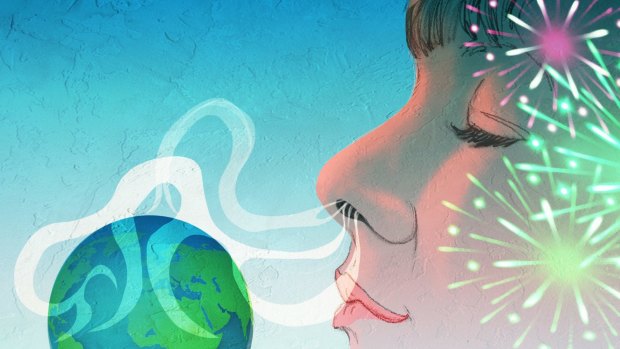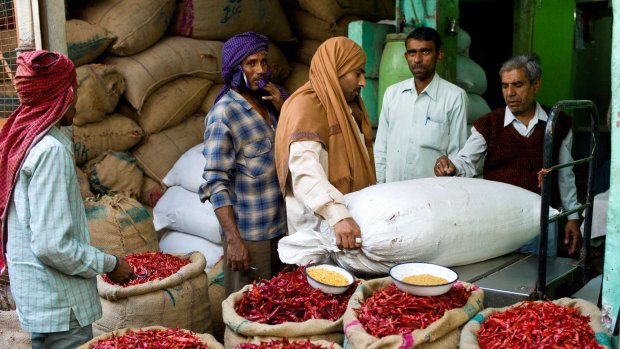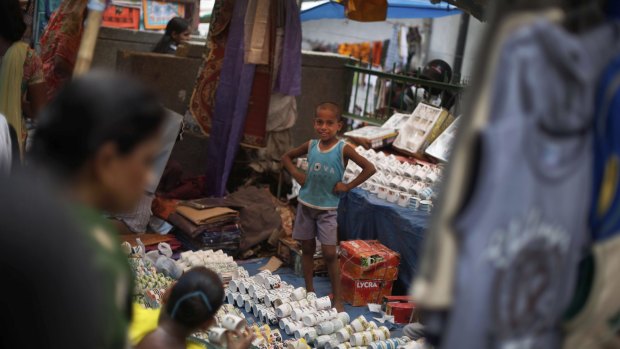This was published 8 years ago
How scents and smells influence our travel choices and experiences
Scents are incredibly powerful, and they can carry you around the world.
By Max Anderson

Aromas are incredibly powerful, and they can carry you around the world. Illustration: Michael Mucci
I love the smell of Old Delhi. It's the smell of life and death and everything in between.
When I first encountered it as a young bloke, I blenched – just as I've seen other first-time visitors variously gag, cough and even cry gently into their handkerchief before asking to be taken home. But right now, here in my air-conditioned Australian office, I can summon it up in my head and feel the longing to be back among those fragrant lanes of cows, chai wallahs and chaos.
We have five million olfactory receptors in our nose and every one of them is constantly recording the notes of where we happen to be. Moreover, scientists believe our sense of smell is a better aide-memoire than we give it credit for: we can lock smells away into our memories and associate them with all sorts of interesting things; similarly, we can unlock those associations using an odour as the key.

The markets of Old Delhi are full of extraordinary smells. Credit: Alamy
So no question, I follow my nose when I travel. I'm aware of smells, I seek them out and I think about them. Take Melbourne. Melbourne smells distinctly more European than Sydney or Brisbane. During the autumn months in particular, moisture combines with the sweet smell of deciduous leaves and the grime of well-beaten pavements to evoke London and Paris; so to me at least, the city smells more serious, older and wiser.
Sydney in the rain doesn't smell right at all (it's a city wearing the wrong season), but the summer smell of salty harbour with notes of marine diesel from hard-working ferries is a cologne that's incredibly sexy.
Eucalyptus oil will always be Australia's signature fragrance and I can't resist pulling leaves from stems to crackle them under my nose. But I also adore the smell of pepper trees growing beside galvanised water tanks – a smell I associate with outback isolation and the hopes of people doing it tough. Still in the outback I can't go past the tough old curry bushes in the Flinders Ranges, which give off the most beguiling scent of honey and ash. No surprise that campfire wood smoke instantly evokes pictures of happy trails, but the scent is much more powerful in a cold dawn. Overlay the smell with hot black coffee (the pot brewing while you struggle into jeans that are cold, stiff and slightly greasy) and the essence of true contentment is complete.

The markets of Old Delhi are full of surprises for the nose.
The cleanest smelling state is without doubt Tasmania: cold ocean currents, the fresh breath of mountains. Someone should bottle it.
At the other end of my olfactory map is the Northern Territory, defined by two especially pungent smells that perhaps help mark it out as our most exotic region. To me, Territory is the smell of the hot afternoon thunderstorm, a weather event so pungent you can write your name in the air.
Overseas perfumes are extraordinarily potent. Charred fish in Asian night markets. Predawn dew on yellow tiger grass in Africa's savannah lands. The seasoned candy fragrances of American interiors, (which I reckon is something to do with the native woods they use in their over-manufactured furnishings).

The nose has it. Photo: Getty-ImagesCredit: Getty & Dirty Dancing
And there's that more prosaic smell that indubitably says international travel – the cocktail of atmospherics in a freshly laundered aircraft. It's mostly informed by the fabrics and polymers of the modern cabin plus the agents used to clean them, and it never fails to set my pulse racing in anticipation.
That said, the receptors in our nose have short spans of attention, and quickly begin looking for new sources of inspiration. They certainly don't have to wait on long-haul flights, which have a predictable progression of smells, an olfactory flight path if you will. After the welcome aboard smell, there's the waft of cooked meals from the galley (fist-pump – yessss!). Then it's a long and steady descent as some 300 digestive systems start to work and the toilets get a hammering. But the ultimate bum note is reserved for international passengers on the return to Australia, when they're spritzed with insecticide before landing.
Ships have a distinct fragrance that's the same the world over, no matter if the vessel's a bucket of bolts servicing Burmese farmers in Yangon, or a six-star floating palace plying the Caribbean. I think it's down to the thick and gooey marine paint used to protect steel – a paint that gets extra-potent when it's hot or splashed with salt water. Whatever it is, it's a form of travellers' catnip that sees me happily bouncing off those steel walls.
Paradoxically, one of the world's most photogenic destinations stinks to high heaven. Antarctica is of course fiercely cold, but it's also dry and has no insect life; couple this with significantly reduced microbial action and you have a part of the world that's not very good at breaking down poop or dead things. I well recall walking into my first penguin colony: underfoot was inches of colourless, paper-flat corpses all smeared with fishy excrement, an aroma-zone so fetid it made my eyes water.
But the Old Delhi principal still holds that, when associated with good times, even bad smells are things to cherish. (I'm usually the only one smiling at the seaside when I catch a whiff of the local shag colony.)
I've never admitted this, but even though I'm a fervent anti-smoker, I confess I miss how pubs used to smell before smoking was banned. My liking for the stink of spilt beer, stale carpets and fags is probably connected to childhood, which leads me to another confession: as a primary-schooler in Britain, I used to walk home past a 1730 coaching inn called The Red Cow; it had a letterbox in the thickly timbered door, and if I lifted the flap and stuck my nose in, I was rewarded with a whiff of Bass Worthington and John Player Specials.
Even when I was safely on the right side of legal drinking age, the stale smell of pubs continued to subconsciously shoot me through me with a thrill of illicit pleasure – one that reliably travelled with me all over the world, because no matter whether I was in a hotel in Sydney, an Irish pub in New York or a bar in Paris, the smell was the same.
Alas, owing to a joint assault by the popularity of hard flooring and the campaigning of the anti-smoking lobby, pubs these days smell no more interesting than offices. Indeed, I'm having to travel further and further to get a fix – Jakarta, Beijing, Ulanbataar. In Europe, I have to go all the way to the fuggy snugs of Vienna's Bermuda Triangle! (Mind you, it's worth it; thanks to centuries of serious political types wearing damp overcoats and smoking like trains, the Viennese have turned fetid bar-stink into high art indeed.)
Considering we're so attuned and susceptible to smell, it's surprising how few travel industry players and experience providers seek to engage or exploit our olfactory sense. But it does happen.
American hotel chains have their own scents to encourage brand loyalty. The Sheraton group is said to like fig, clove and jasmine; Westin prefers white tea, while Holiday Inn opts for citrus and white tea, with 'undercurrents of herbs, perilla leaf, woods and a sensual musk'. Piping ambient musks into lobbies through the air-conditioning ducts is a standard practice, though smarter operators understand visible sources of scent (candles, incense sticks and pot pourri) are a more sophisticated way to go.
The Jorvik Viking Centre in York has piped the smells of cesspits and fish into a village reconstruction to give visitors a taste of how the Viking smelled. To celebrate the museum's 30th anniversary they released 'Norse Power', a deodorant to help men (and I presume women) smell like a Viking warrior. Scientists got serious about it and blended a range of fragrances including mead, 'blood and gore', smoke, seawater, mud, sweat, animal meat and fresh pine.
Scents and sensibilities clashed earlier this year when the National Museum of Singapore created a scent to capture 'the horror and hardship of the Japanese Occupation of Singapore'. The scent, called 'Fear', was designed to evoke one of 12 different chapters of Singapore's 700-year history. It took 34 tries for a parfumier to hit the right notes of blood and sweat, but early attempts were found to be too upsetting to staff, and had to be toned down.
Personally, I find the idea of a unique, lost or 'historical smell' completely fascinating.
The old whaling station in Albany (called 'Whale World') still has the machinery that was used to chop, grind and boil whales down to useful oils: though the industry has long gone, the soapy-sweet smell has not. The wondrous 19th century 'Battery' shed in Charters Towers where ore was pulverized and the gold extracted with poisonous chemicals is similarly a blast from the past.
On the ghost tour of Port Arthur I remember our guide asking the group if we could smell anything in the truly awful Dissection Room. After some judicious bouts of inhaling in the darkened space, a few of us managed to get past the smell of our kerosene lamps to suggest there was a feint smell of peppermint or menthol. At this the guide concurred – and suggested that it was the relic smell of chloroform. The shudder that went through the group may have been imagined but the smell was real.
Perhaps the most interesting smell I ever encountered on my travels was one that brought the past and present together. It was neither pleasant nor unpleasant, but it rocked me on my heels. On a walking safari in Tanzania, I entered a remote high country village of Masai. The settlement was tiny, half a dozen grass huts with several enclosures of thorn. There were no roads in or out, in fact walking seemed to be the only way to reach this place. At first it seemed no-one was here and we simply walked by, but then a young woman in a red shawl appeared from her hut of straw and beaten earth.
She approached, took my hand and regarded me closely; she smelt of mud and animal fats and something else. It was blood – the blood of a cow, which she would tap each day from the animal's warm, fat jugular and drink mixed with milk.
She kept looking at me, gripping my hand, appearing uncertain what exactly I was. And I did the same to her, stunned by the primal culture I'd discerned from her smell.
After a few moments, I turned to catch up with my group and I was struck by a thought – how had I smelled to her?
Probably floral and saccharine. And faintly ridiculous.
Sign up for the Traveller newsletter
The latest travel news, tips and inspiration delivered to your inbox. Sign up now.